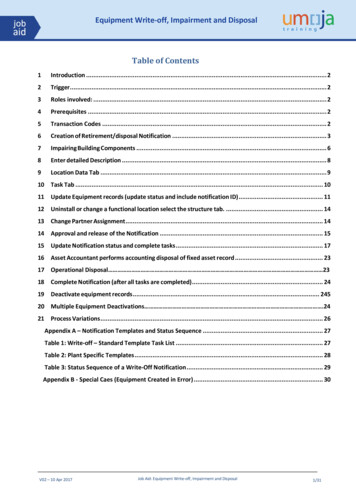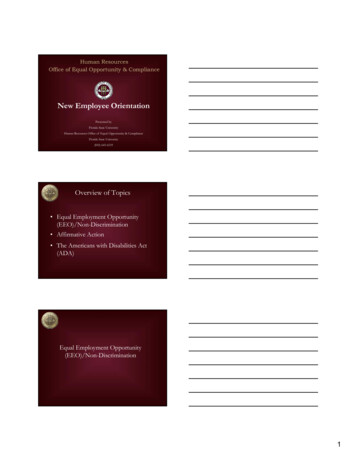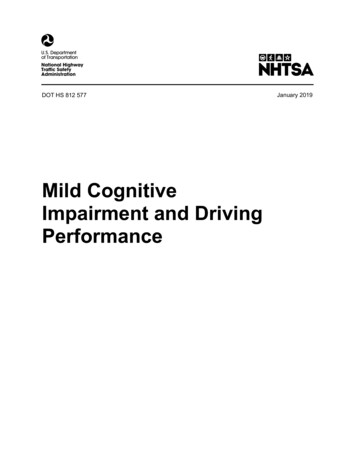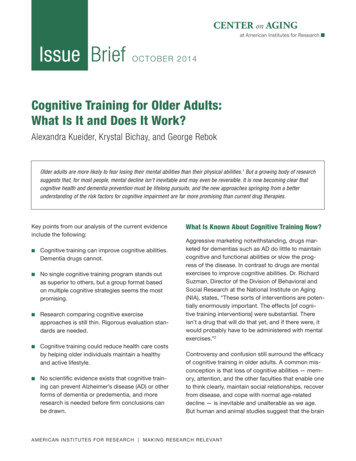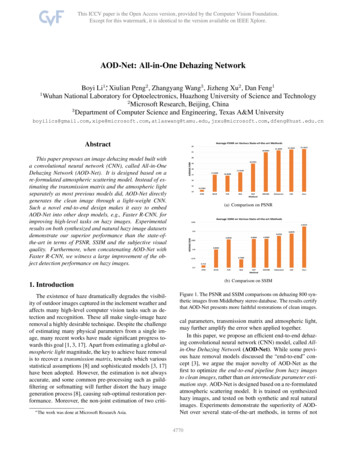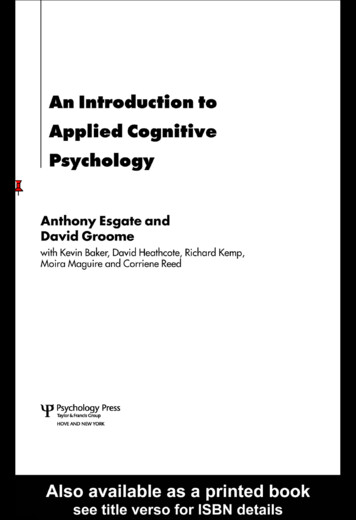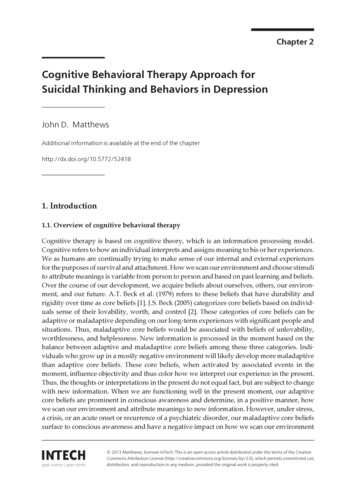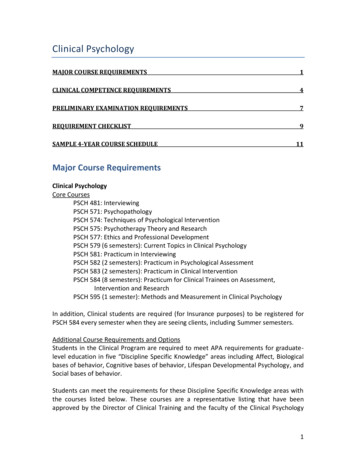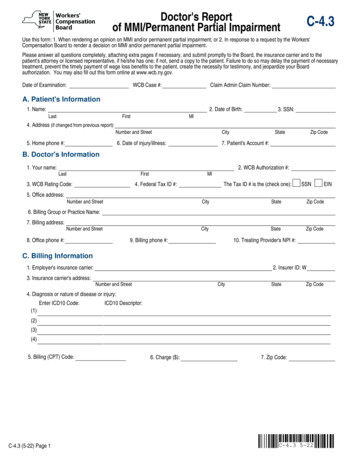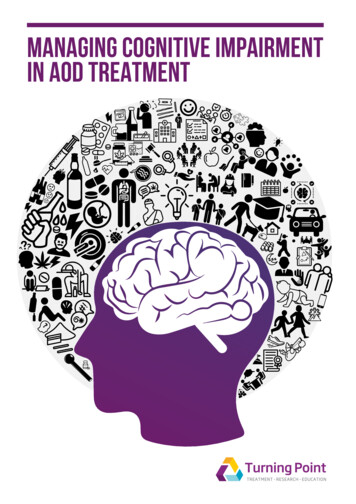
Transcription
Managing Cognitive impairmentin AOD treatment
ManagingCognitive impairmentin AOD treatmentPractice guidelines for healthcare professionals2021Victoria ManningJames GoodenCatherine CoxVanessa PetersenDanielle WhelanKatherine MrozCopyright 2021 State of Victoria.ISBN: 978-1-74001-032-0 epubReproduced with permission from the Victorian Minister for Mental Health. Unauthorised reproduction and otheruses comprised in the copyright are prohibited without permission.Copyright enquiries can be made to Turning Point, 110 Church Street, Richmond, Victoria 3121, Australia.Published by Turning Point.The responsibility for all statements made in this document lie with the authors. The views of the authorsdo not necessarily reflect the views and position of the Victorian Department of Health or Turning Point. Thecorrect citation for this publication is: Manning, V., Gooden, J. R., Cox, C., Petersen, V., Whelan, D., & Mroz, K.(2021). Managing Cognitive Impairment In AOD Treatment: Practice Guidelines for Healthcare Professionals.Richmond, Victoria: Turning Point.AcknowledgementsIn the revisions of this resource Turning Point acknowledges the considerable contribution of the authors of theprevious version: Richard Cash & Amanda Philactides.
CONTENTSOPIOID REPLACEMENT THERAPY: METHADONE & BUPRENORPHINE39OTHER 39WHAT IS COGNITIVE FUNCTIONING?7Inhalants & Solvents40WHAT IS COGNITIVE IMPAIRMENT?11Benzodiazepines40CAUSES OF COGNITIVE IMPAIRMENT13Nitrous Oxide40Acquired Brain Injury (ABI)14NOVEL PSYCHOACTIVE SUBSTANCES (NPS)41Traumatic Brain Injury (TBI)15ASSESSMENT AND DIAGNOSIS OF COGNITIVE IMPAIRMENT42Stroke16Hypoxic Brain Injury17Neurodegenerative and other Neurological Conditions18Neuropsychological Test Batteries47Blood Borne Viruses18Self-Report Measures of Cognitive Functioning4719Client Interview & History Taking48The Brain Disease Model of Addiction19Collaborative History Taking & Psychosocial History50Interpreting AOD Literature on CI20Client Substance Use, Dependence and Treatment History50Overall Prevalence of CI in People With Current AOD Problems21Prescription Medications5122Developmental History53Alcohol Related Brain Injury22Medical History54Harms Associated with Chronic Alcohol Use23Brain Imaging & Assessment56Cognitive Impact of Alcohol Use25Exploring Risk of TBI58Influencing Factors28Psychosocial Functioning59Cognitive Recovery28Mental Health & Trauma59When to Refer for Neuropsychological Assessment?29How Does Mental Health Impact on Cognition?60COGNITIVE IMPAIRMENT MEANING & SIGNIFICANCECOGNITIVE IMPAIRMENTNeuropsychological AssessmentCOGNITIVE SCREENINGCOMPLEX POPULATIONS424762DRUG RELATED COGNITIVE IMPAIRMENT30CANNABIS RELATED COGNITIVE IMPAIRMENT31Corrections & Forensic Settings62Cannabis and Mental Health32Aboriginal and Torres Strait Islanders65Effects of Cannabis on Cognition32Culturally and Linguistically Diverse (CALD) Populations66Influencing Factors33Cognitive Recovery33Internal Strategies6734External Strategies69Methamphetamine Related Cognitive Impairment35Lifestyle Recommendations71Cocaine Related Cognitive Impairment36TREATMENT PLANNING73Ecstasy Related Cognitive Impairment36ADAPTING PSYCHOSOCIAL INTERVENTIONS74STIMULANT RELATED COGNITIVE IMPAIRMENTOPIOID RELATED COGNITIVE IMPAIRMENT3COMPENSATORY STRATEGIES FOR COGNITIVELY IMPAIRED CLIENTS6738Turning PointCognitive Impairment and Substance Use: Guidelines for Alcohol and Drug Clinicians4
Adapting Delivery74Impaired Attention & Information Processing Speed74Language Difficulties75Visuospatial Impairment75Memory Impairment75Executive Functioning: Abstract Thinking75Impaired Mental Flexibility75Problem Solving Problems76Impulsivity76Poor Insight77Poor Social Cognition77Therapeutic Approach78Session Structure79COGNITIVE REHABILITATION80Working Memory Training81Response Inhibition Training81Cognitive Bias Modification82Goal Management Training83Brain Stimulation Methods84Heart Rate Variability Biofeedback84Physical Activity85Cognitive Enhancing Drugs85APPENDICES5Alcohol and other drugs (AOD) influence brain function and subsequently our thinking, emotions and behaviour. Lossof control and continued substance use despite negative consequences are hallmark characteristics of addiction.People seeking treatment for AOD use disorders often experience impaired cognitive functioning, particularly poorattention, working memory, inhibition, planning, organisation and decision-making. Cognitive impairment (CI) canadversely influence treatment engagement, adherence, completion and outcomes.Clients are often concerned about the harmful effects of AOD use on brain health, and thus an understanding of the nature,severity and duration of AOD-related CI can inform care-plans. Specifically, knowing an individual’s cognitive strengthsand difficulties can help shape the delivery of psychosocial interventions, the need for referral to neuropsychologicalservices, the application of compensatory strategies, and the potential benefit of cognitive rehabilitation. However, whilstconsidering an individual’s level of cognitive functioning can be helpful clinically, it is important to avoid using diagnosticlabels such as “Acquired Brain Injury” or ABI unless a formal diagnosis has been conveyed, as these labels could bedetrimental to self-efficacy and motivation for behaviour change.These guidelines provide practical strategies for the management of CI informed by the latest scientific and grey literatureconcerning best practice, emerging approaches and clinical expertise. The development of these guidelines involved anextensive review of the literature, consultation with clinical neuropsychologists and other AOD clinicians. It is importantto emphasise that these guidelines should be read in conjunction with workplace policies, and should never replace theapplication of sound clinical judgment.86Appendix A: Common Screening Tools – Are They Appropriate?86Appendix B: Accessing Support for TBI89Appendix C: Accessing Funding & Support for CI90Appendix D: Screening for Mental/Psychiatric Health Issues93Appendix E: Victorian Neuropsychology Services95BIBLIOGRAPHYINTRODUCTION96Turning PointCognitive Impairment and Substance Use: Guidelines for Alcohol and Drug Clinicians6
WHAT IS COGNITIVE FUNCTIONING?VisuoSPATIAL functionCognition refers to the brains ability to collect, assimilate, organise, store and manipulate information. As such,cognitive functioning is an umbrella term that encompasses a range of integrated skills and domains that allow us toprocess and respond to information within our environment.These domains range from basic functioning (e.g., processing speed, attention) through to highly complex goal-orientedskills (e.g., executive functioning such as planning or decision making). An example of the pyramid model of cognitivefunctioning is shown below in Figure 1, which highlights the key domains and their relative level of complexity (with morecomplex functions represented towards the top of the pyramid).Visuoperceptual and visuospatial functioning describes abilities that allow the brain to make sense of sensory information(e.g., object or face recognition) and interpret this information in a spatial context (e.g. judging depth, distance, the spatialorientation of objects).Language and communicationLanguage skills comprise two broad categories:a)b)Expressive language skills: Communicating via speech, writing or gesture;Receptive language: The ability to understand and comprehend language.Language skills also include object naming, word finding, fluency, grammar and syntax.EXECUTIVEfunctioningInformation is fed downeach levelLearning & memoryMemory and LearningIncreasing complexity ofthought and informationprocessingMemory and learning refers to our ability to hold and retain information over time and is reliant on specific structureswithin the temporal lobes of the brain. The stages of memory formation are as follows:1)2)3)Language & communicationEncoding: This is the process by which information is acquired;Consolidation: The process of storing information in long term memory;Retrieval: The process of accessing or retrieving information from long term memory stores.VisuoSPATIAL functionAttention/CONCENTRATIONFigure 1. Hierarchy of Cognitive FunctioningATTENTIONInformation Processing SpeedENCODINGSTORAGERETRIEVALFigure 2. Stages of Memory FormationProcessing or ‘thinking’ speed refers to how quickly the brain can process sensory information or perform a mental task.Memory SystemsAttentionAttention refers to one’s ability to process incoming information from the body’s sensory systems. This domain is madeup of various skills, including, focussed or selective attention (i.e. concentration), sustained attention or vigilance - andat the higher end of complexity, divided attention (performing multiple tasks at the same time). Generally these skillsunderpin higher level cognitive functions and consequently poor attention can impact on a variety of other cognitivedomains.7Turning PointMemory functions can be classified into several distinct processes, each of which serves a particular role in our abilityto remember information. This model is illustrated below, however, for most clinicians it may be more helpful toconsider the following (more practical) distinctions: Verbal & Visual Memory: The left cerebral hemisphere (left hand side of the brain) typically process verbalinformation and the right cerebral hemisphere visual or spatial information. We are sometimes better at learningor remembering visual information (diagrams, pictures or faces) than verbal information (e.g. spoken or writteninformation or names) or vice versa.Cognitive Impairment and Substance Use: Guidelines for Alcohol and Drug Clinicians8
Recent versus Remote Memory: This refers to the temporal sequence of memories. In the case of memoryimpairment, recollection of more recent events or memories is likely to be impacted (e.g. due to damage preventingadequate encoding and storage of information) rather than to well preserved, remote (long-term) memories thatwere processed prior to any damage occurring.Table 1. Executive Functioning SkillsExecutive FunctionHealthy FunctioningPlanningThe ability to organise, prioritise and plan a taskDecision-makingThe ability to solve problems & weigh up alternativesInhibitionThe ability to restrain or inhibit an actionConcept formationThe ability to form an understanding of an ideaLong - TermMEMORYAbstract thinkingThe ability to “think outside the box” or reason with and considerprinciples and ideas removed from the objects themselvesthe ability to storeinformation for extendedperiods of timeMental flexibilityThe ability to hold multiple pieces of information in one’s mind orswitch between sets of informationProspective Memory: Involves remembering to perform an action or recall an intention at some point in the future(i.e., remembering to pay a bill in two days’ time).Priming: Exposure to a stimulus can influence one’s response to a later stimulus.MEMORYSENSORYMEMORYThe ability to retainimpressions of sensoryinformation (for a fewseconds)WORKINGMEMORYThe ability tohold/manipulateinformation inconscious awarenessWorking MemoryEXPLICITMEMORYIMPLICITMEMORYMemories inconscious awarenessMemories outsideconscious awarenessWorking Memory is a specific cognitive domain which refers to the ability to hold information in mind and manipulate it in orderto perform a specific task (e.g., mental arithmetic, dialling a phone number, or following a set of directions). Some researcherssuggest that working memory is a foundational executive function which underpins most cognitive functions mories of eventsand experiencesMemories of factsand conceptsMemory of skillsSocial & Emotional CognitionSocial cognition refers to the capacity to detect emotions and intentions in others. The two subsets of social cognition are: Figure 3. Overview of Memory TypesExecutive FunctioningTheory of Mind: Relates to the capacity to attribute beliefs, desires and intentions to both oneself and to others.This helps us understand why someone acts in a certain way and allows us to predict how someone might act.Emotion Recognition: Relates to the ability to infer an emotional state in someone else.General intellectual functioning (IQ)Executive functioning is an umbrella term that refers to a set of effortful processes involved in goal-directed beahiours,involving inhibition, mental flexability and working memory. Theses processes enable us to make adaptive responses tonovel, complex or ambiguous situations. Executive functions are predominantly governed by the frontal lobes of the brain.Executive functioning is sometimes split in to “hot” and “cold” neurocognitive functions (EF) in adults with a substanceuse disorder. Hot EFs are those involving emotional awareness, affective responses and social perception (e.g., socialcognition), whilst Cold EFs refers to the more mechanistic higher-order cognitive operations (e.g., working memory) andrational decision-making.General intellectual functioning or ‘crystallised intelligence’ can be conceptualised as a global or unitary estimate ofan individual’s cognitive functioning across a range of domains. Commonly employed measures of intelligence yield anintelligence quotient (IQ), a total score derived from a collection of tests assessing multiple domains that are standardisedbased on an individuals’ chronological age. IQ scores can be helpful in contributing to diagnostic formulations (e.g., forintellectual disability) or evaluating an individual’s ability, however, in other circumstances they may not appropriatelyreflect an individual’s cognitive functioning or level of CI.9Cognitive Impairment and Substance Use: Guidelines for Alcohol and Drug CliniciansTurning Point10
WHAT IS COGNITIVE IMPAIRMENT?Table 2. Behaviours Indicative of CICognitive impairment (CI) refers to suboptimal cognitive functioning involving decline in one or more cognitivedomains as a result of damage or disruption to neural structures or networks. When considering whether anindividual is cognitively impaired, one must first consider what is normal for an individual and relative to otherindividuals their age.Overall IQ (intelligence quotient) scores are a good example of this. In a ‘normal’ healthy population, 50% of individualswould be expected to score between 90 (lower IQ) and 110 (higher IQ) on an IQ test, and very few would be expected to score130 (very high IQ) or more. If someone scored 85 but had previously scored 110, this could be considered an impairment,however, if that same person had always scored 85, then this could be considered normal (i.e., no impairment). It isimportant to remember that some skills are highly influenced by an individual’s age and level of education. A finalconsideration is that we all have our own strengths and weaknesses, and some people are naturally better with wordsand verbal information while others might be better with processing visual or pictorial information.Cognitive DomainExample behaviour or complaintAttention & Concentration Client makes repeat requests to clarify or explain informationClient lacks focus, is easily distracted, or misplaces itemsInformationProcessing Speed The client is slow to respond to questionsClient is easily overwhelmed or appears to miss informationWorking Memory Client loses track of what someone else is saying inconversations, or forgets what they were going to sayCan’t follow plots (books or film)Client has difficulty keeping multiple pieces of informationin mind (e.g. makes requests to repeat a phone numberthat needs to be dialled)Trouble working through problems in one’s head (e.g.calculating change owed) Behavioural Indicators of Cognitive ImpairmentVisuospatial PerceptionWhen individuals initially report cognitive difficulties it can be challenging to tease apart which cognitive domains may beimpacted. Impairment in one cognitive domain can impact other cognitive domains. For instance, impaired attention canlead to memory problems because the individual is not attending to information sufficiently for it to be encoded properly.Nevertheless, some general patterns and common complaints are highlighted in Table 2. It may be helpful to referback to this table when reading these guidelines as it offers context into the types of everyday behaviours clients maypresent with. Where CI is the result of serious brain damage there may also be additional impairments in sensory, motor,behaviour or emotional domains. Other common behaviours reflecting executive functioning deficits in particular, includeincreased frustration/irritability, socially inapproproiatre behaviour, we well as changes in emotional responsiveness/expression (e.,g being flat or elevated) or reduced emotional regulation (e.g., volatile reactions). Language Memory Executive Function Social Cognition 11Turning PointClient bumps into stationary objects, neglects or ignoresdistinct areas in their environmentClient gets easily lost in otherwise familiar environments.Client misidentifies objectsNavigational difficultiesNon-fluent (clunky) or effortful speechWord finding difficulties (frequent pauses in conversation,or may describe the word they cannot recall)Difficulty comprehending others speechClient forgets appointments, previous conversations,names of people or places, details, events, objectsVague recall of eventsDifficulties learning new information such as a new skillPoor ‘orientation’ (time, place, date)Inability to multitask (e.g., can’t focus on more than onething at a time)Problems communicating details of a story in a sequential/organised wayImpulsive behaviourLack of insightConcrete rigid/thinking (can’t generalise learned info/understand metaphors)Difficulty monitoring one‘s behaviourDifficulty adapting to changing situations or environmentsDifficulty planning and organising behaviourChanges in thinking patterns and sometimes personalityDifficulty problem-solvingDifficulty discerning emotional cues, misinterptretingothers’ thoughts and intentionsHostile defensive, argumentative behaviourCognitive Impairment and Substance Use: Guidelines for Alcohol and Drug Clinicians12
CAUSES OF COGNITIVE IMPAIRMENTSarah’s Story: Transient CIHow do Substances AFfect Cognitive Functioning?Sarah’s story illustrates the value of residential rehabilitation, nutrition and improved mental health oncognitive functioning.Psychoactive substances dysregulate several neurotransmitter systems that underpin cognitive functioning. Forexample, long term stimulant use (i.e., methamphetamines) causes both short-term and long-term neuroadaptationsin dopamine, noradrenaline and serotonin systems responsible for (among other things) attention, learning, mood, andmemory formation. Alcohol primarily disrupts the GABA and glutamate system, cannabis disrupts the endocannabinoidsystem, and opioids (i.e., heroin) effect the endogenous opioid system (Mu-receptor agonists). Each of these substancesultimately effect dopamine, altering the fronto-striatal system which governs executive functioning, decision-making andemotion regulation. It may be helpful to explain to clients that substance use can cause neurotransmitters to becomedepleted, as the brain learns that it no longer needs to produce as much dopamine, serotonin or other neurotransmittersmimicked by the drug. After a binge-episode, it can take a few days for these neurotransmitters to be restored to theirnormal levels, during which time the client may experience negative symptoms such as fatigue and low mood. Withchronic long-term use, the time required for neurotransmitters to replenish increases, which can reinforce the cyclicnature of substance use.Sarah is a 65-year-old female who was referred to neuropsychological assessment after being admitted toa long-term residential AOD rehabilitation program. This was the second time she had been admitted andclinicians noticed she had declined cognitively and were concerned about her having an acquired brain injuryor dementia.What Causes Cognitive Impairment?There are many factors that can cause or contribute to CI. This is most notable in the AOD sector, where individualscan present with multiple comorbid diagnoses, injury, and various environmental and developmental stressors. It isimportant to note that not all causes of CI result in permanent change and many are transient or modifiable. As such, itis important to obtain a comprehensive history from clients to identify areas for immediate multidisciplinary interventionand treatment, and refer on to specialist assessment if required. The following section details both persistent andtransient causes of CI.Sarah was suffering from grief after losing several family members and had been drinking alcohol every dayfor over 20 years as a coping mechanism. Prior to being admitted for rehabilitation, Sarah had not been lookingafter herself, felt depressed, had poor nutrition, could not clean her house, and avoided socialising.During detox, Sarah was treated with thiamine, and during rehabilitation regularly saw a psychiatrist whoprescribed anti-depressants and helped Sarah to discuss her grief and trauma. By the time she was seen for anassessment she had been abstinent for two months and was regularly participating in social and recreationalprograms at the rehabilitation centre. She was eating and sleeping well and getting exercise by swimming inthe pool. Sarah was feeling more positive about life. Her neuropsychological assessment showed only mildweaknesses in some higher level executive skills such as planning and dividing attention, while all her otherskills fell in the normal range for someone her age and as such there was no evidence for dementia or anacquired brain injury.During the feedback session Sarah was relieved to hear this news as it had been weighing on her mind. Shewas advised to continue engaging in all the activities she had been doing which were making a big differencein helping her feel productive and positive, and her support workers were planning how to ensure a smoothtransition for her return to the community.Table 3. Persistent and Transient Causes of CIPersistent CausesTransient CausesAcquired Brain Injury*Psychological conditionsTraumatic Brain Injury*Acute substance use/intoxicationNeurodegenerative conditionsSleep deprivation & insomniaChronic medical conditionsAcute medical conditionsDevelopmental disorders (i.e., ADHD,Autism, intellectual disability)Stress caused by homelessness,social isolation, abuse, socioeconomic disadvantageAcquired Brain Injury (ABI)ABI refers to damage that has occurred to the brain after birth resulting in the deterioration of cognitive, physical,sensory, emotional or independent functioning. Impairment can arise from traumatic injuries (referred to asTraumatic Brain Injury [TBI]) or non-traumatic injuries such as stroke, hypoxia or anoxia, infection (i.e., meningitisor encephalitis), poisoning, brain tumours, prolonged AOD misuse or drug overdose. ABI is differentiated fromdevelopmental disability, psychiatric illness, or degenerative neurological diseases (i.e., Alzheimer’s disease,Multiple Sclerosis, and Motor Neurone Disease), however, these disorders can and do co-occur. Around 1 in 45 (or432,700) Australians have an ABI (2), however the prevalence is often higher in certain populations (i.e., prison andindigenous populations and those with substance dependence or severe psychiatric illness).*The persistence of impairments associated with ABI and TBI will vary based on severity of injury and individual differences.13Turning PointCognitive Impairment and Substance Use: Guidelines for Alcohol and Drug Clinicians14
Traumatic Brain Injury (TBI)TBI versus ConcussionTBI is defined as an alteration in brain functioning as a result of external force (i.e., when the head has been subjected toa severe blunt force trauma or a penetrating injury from a projectile or sharp object). These injuries can result in the brainshifting inside the skull, causing damage to areas that make contact with the skull (contusions), rupture of blood vessels,or neuronal damage leading to a range of sensory, motor, cognitive, emotional and behavioural changes (3). There is oftena loss of conciousness for several minutes, neurological investigation and hospitalisation. The impact of these changescan range from being very mild through to exceptionally disabling affecting a client’s day-to-day functioning (dependingon the brain regions affected). It is important to note that not all head injuries result in a TBI. Studies have shown thatapproximately 80% of individuals admitted to hospital with TBI are classed as having a mild TBI, and that the majority ofsymptoms are generally expected to resolve within several months (3, 4).In the AOD sector, clients frequently report incidents of head injury (5). For instance, in a recent review of clients presentingto a specialist neuropsychological assessment service, 41% of clients reported having sustained a head injury (6). However,of these incidents, TBI was considered to be a major contributing factor in only 7% of these cases. Consequently, cliniciansshould avoid potentially misattributing their clients CI to relatively benign instances of head injury – particularly whenthat injury is not followed by an extended period of loss of consciousness ( 30 minutes).Compare the two cases: one demonstrated significant cognitive impairment while the other performednormally on assessment.Brett was assaulted while on a night out with friends. He struck his head and briefly lost consciousness but left thescene before the ambulance arrived. He has a history of depression and anxiety in addition to polysubstance use.He feels his memory is worse since the assault.Larry was assaulted while on a night out with friends. He struck his head, was knocked unconsciousness andtaken to hospital by ambulance. Medical notes indicate he was intubated and ventilated on arrival to hospital andremained in a coma for several days. Brain imaging revealed he had experienced bleeding on the brain in additionto a skull fracture. He has no recollection of the event and had to be told what happened. His first recollectionwas waking up in hospital but he was unsure how long after this was. He reported having a fuzzy recall of eventsin the days following the assault. After waking up he was unable to remember new information for 3 days. He wastransferred to a rehabilitation hospital where he stayed as an inpatient for two weeks. In the weeks following theincident he noted feeling irritable, frustrated, slowed down and was having difficulty recalling information.Brett’s case is an example of a mild or concussive injury where a full recovery would likely be expected and hisreported complaints are likely secondary to substance use or mental health difficulties. Brett would be referredfor psychological assessment and support. Larry’s case is an example of a client who sustained a severe traumaticbrain injury and showed significant cognitive impairments on assessment. Larry would receive continuedmultidisciplinary rehabilitation support with input from neuropsychology, psychology, occupational therapy andsocial workers.TBI & AODThose with pre-existing TBI, post-injury and pre-existing CI are more likely to subsequently develop a substance usedisorder (SUD), particularly when injury is sustained during childhood through to young adulthood (7, 8). Among thoseindividuals who sustain a TBI, it is well established that alcohol consumption can undermine rehabilitative outcomes,increase seizure rates (including alcohol withdrawal seizures), psychiatric difficulties, and the likelihood of further TBI(9, 10). Pagulayan, Temkin, Machamer, & Dikmen (2016) found that approximately half of their patients with TBI drank inthe moderate (1–2 drinks between three and six times per week, or 3–4 drinks on 1–4 occasions per week) to heavy(consuming alcohol seven or more times a week) range prior to their head injury (11). Six months after sustaining a TBI,30% had returned to drinking, with 20% of these drinking heavily. The authors highlighted that early intervention in thefirst 6 months post-injury is crucial in terms of managing alcohol use post TBI.StrokeStrokes are classified as either ischaemic (a blockage or clot in an artery causing an obstruction in blood flow) or ashaemorrhagic (bleeding in the brain). Stroke’s that are haemorrhagic are often the result of either an arteriovenousmalformation (AVM) (an abnormal tangle of blood vessels disrupting blood supply to the brain), or an aneurysm (anabnormal bulge in a blood vessel wall bursts) (12).15Turning PointCognitive Impairment and Substance Use: Guidelines for Alcohol and Drug Clinicians16
The Australian Stroke Foundation recommends the‘F.A.S.T’ test to help recognise signs of stroke (13).1. Face: Check their face. Has their mouth drooped?2. Arms: Can they lift both arms?3. Speech: Is their speech slurred? Do they understand you?4. Time: Is critical. If you see any of these signs call 000 straight away.Neurodegenerative and other Neurological Conditions1234In older clients ( 60/65 years) progressive cognitive decline can be indicative of a neurodegenerative condition suchas Alzheimer’s disease, other forms of Dementia, Parkinson’s disease, or Huntington’s disease. If there are concernsabout significant decline in cognitive or functional ability, or an undiagnosed neurodegenerative condition, this should bedocumented and a GP referral sought in the first instance.Common measures or screens of CI will not reliably detect dementia. A person with a good education may score verywell on these scales and still have dementia, while a person who is poorly educated may score below the cut-off andnot have dementia. Many other issues affect the score, inclu
Verbal & Visual Memory: The left cerebral hemisphere (left hand side of the brain) typically process verbal information and the right cerebral hemisphere visual or spatial information. We are sometimes better at learning or remembering visual information (diagrams, pictures or faces) than verbal information (e.g. spoken or written

